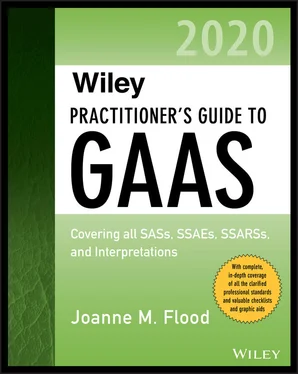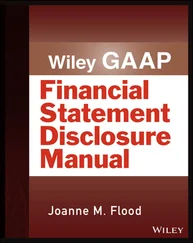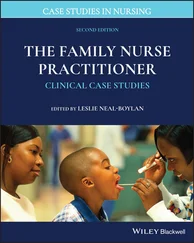Source: AU-C 260.06.For definitions related to this standard, see Appendix A, “Definitions of Terms”: Management, Those charged with governance.
OBJECTIVES OF AU-C SECTION 260
The objectives of the auditor are to:
1 communicate clearly with those charged with governance the responsibilities of the auditor regarding the financial statement audit and an overview of the planned scope and timing of the audit.
2 obtain from those charged with governance information relevant to the audit.
3 provide those charged with governance with timely observations arising from the audit that are significant and relevant to their responsibility to oversee the financial reporting process.
4 promote effective two-way communication between the auditor and those charged with governance.
(AU-C Section 260.05)
REQUIREMENTS
Those Charged with Governance
AU-C 260.09 and AU-C 206.A6–.A9 provide some guidance on how the auditor should determine which persons or bodies are “those charged with governance” (see “Definitions of Terms”). Governance structures vary by entity; however, in most entities, governance is the collective responsibility of a governing body, such as a board of directors, a supervisory board, partners, proprietors, a committee of management, trustees, or equivalent. In some entities, one person, such as the owner-manager, may be the sole person charged with governance of the entity.
When “those charged with governance” are not clearly identifiable, the auditor and the engaging party should agree on the person(s) with whom the auditor will communicate. In those situations where the entity’s governance structure includes subgroups (e.g., an audit committee), the auditor also should evaluate whether communication with a subgroup is sufficient.
Matters to Be Communicated
The auditor should communicate with those charged with governance:
The auditor’s responsibility under generally accepted auditing standards, that is, forming and expressing an opinion on statements prepared by management with oversight by those charged with governance in accordance with the applicable financial reporting framework.
The fact that the audit of the financial statements does not relieve management or those charged with governance of their responsibilities.
An overview of the planned scope and timing of the audit.
Significant findings from the audit.
(AU-C 260.10–.12)
The auditor may communicate matters such as:
The auditor is responsible for performing the audit in accordance with GAAS.
An audit is designed to obtain reasonable, not absolute, assurance.
An audit includes consideration of internal control as a basis for designing audit procedures, but not for expressing an opinion on the effectiveness of internal control over financial reporting.
The auditor is responsible for communicating significant matters related to the audit that are relevant to the responsibilities of those charged with governance.
The auditor is responsible for communicating particular matters required by laws or regulations, agreement with the entity, or additional requirements applicable to the engagement.
(AU-C 260.A13)
Overview of the Planned Scope and Timing of the Audit
The auditor should communicate an overview of the planned scope and timing of the audit. To meet that general requirement, the auditor may communicate matters such as the following:
How the auditor proposes to address the significant risks of material misstatement.
The auditor’s approach to internal control.
The application of materiality in planning and executing the audit.
Where the entity has an internal audit function and the internal auditors can work together in a constructive manner, the extent to which the auditor will use internal auditors.
The views of those charged with governance about:The appropriate person(s) in the entity’s governance structure with whom to communicateThe allocation of responsibilities between those charged with governance and managementThe entity’s objectives and strategies, and the related business risks that may result in material misstatementsMatters those charged with governance consider to warrant particular attention during the audit, and any areas where they request additional procedures to be undertakenSignificant communications with regulatorsOther matters those charged with governance believe are relevant to the audit of the financial statements
The attitudes, awareness, and actions of those charged with governance concerning (1) the entity’s internal control and its importance in the entity and (2) the detection or the possibility of fraud.
The actions of those charged with governance in response to developments in financial reporting, laws, accounting standards, corporate governance practices, and other related matters.
The actions of those charged with governance in response to previous communications with the auditor.
(AU-C 260.A20–A21)
The auditor should communicate the following matters:
The auditor’s views about qualitative aspects of the entity’s significant accounting practices, including accounting policies, accounting estimates, and financial statement disclosures.
Significant difficulties, if any, encountered during the audit.
Disagreements with management, if any.
Other findings or issues, if any, arising from the audit that are significant and relevant to those charged with governance.
(AU-C 260.12)
The auditor should communicate significant difficulties, if any, encountered during the audit; these may include:
Significant delays in management providing required information.
An unnecessarily brief time within which to complete the audit.
Extensive unexpected effort required to obtain sufficient appropriate audit evidence.
The unavailability of expected information.
Restrictions imposed on the auditors by management.
Management’s unwillingness to provide information about management’s plans for dealing with the adverse effects of the conditions or events that lead the auditor to believe there is substantial doubt about the entity’s ability to continue as a going concern.
(AU-C 260.A26)
The auditor should also communicate uncorrected misstatements, other than those the auditor believes are trivial. This information should include the effect they may have, individually or in the aggregate, on the auditor’s opinion. Material uncorrected misstatements should be identified individually, and the auditor should request that they be corrected. So, too, the auditor should communicate the effect of uncorrected misstatements related to prior periods. (AU-C 260.13)
Unless all those charged with governance are involved in managing the entity, the auditor also should communicate:
Material corrected misstatements that were brought to the attention of management as a result of audit procedures.
Written representations the auditor is requesting from management.
The auditor’s view of management’s consultations with other accountants.
Significant issues, if any, that were discussed, or the subject of correspondence, with management.
(AU-C 260.14)
The auditor should communicate, on a timely basis, with those charged with governance regarding the timing and expected general content of communications. (AU-C 260.15) The auditor may also communicate matters such as:
The purpose of communications. When the purpose is clear, the auditor and those charged with governance are in a better position to have a mutual understanding of relevant issues and the expected actions arising from the communication process.
Читать дальше












